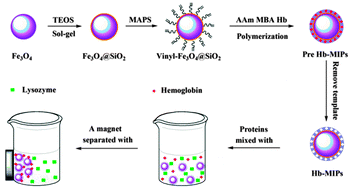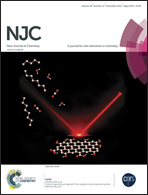Protein imprinting over magnetic nanospheres via a surface grafted polymer for specific capture of hemoglobin
Abstract
Combining surface molecular imprinting with a nano-sized physical form is an effective technology to achieve a large binding capacity and overcome template removal within molecularly imprinted polymers (MIPs), and is in particular advantageous to the template of bulky structures like proteins. In addition, the surface protein-imprinted polymers immobilized on nanospheres with magnetic function are more attractive in the research of selective recognition and enrichment of proteins. In this work, we have demonstrated a facile method, enhancing specific recognition of multifunctional molecularly imprinted magnetic nanospheres with core–shell structure. It was achieved simply via radical induced graft polymerization of low concentration monomers on the surface of vinyl groups modified magnetic nanospheres dispersed in aqueous media using hemoglobin (Hb) as a template. The possible gelation of the dispersion after polymerization was avoided and hence the imprinted magnetic particles without an obvious agglomerated phenomenon could be collected readily and expediently. Finally, a highly monodisperse magnetic nanospheres were synthesized successfully. The morphological studies of the resultant MIPs-coated magnetic particles were characterized using various methods. In batch rebinding tests, the imprinted magnetic particles reached saturated adsorption within 30 min and exhibited significant specific recognition towards the target protein molecules with a binding capacity as high as 281.94 mg g−1 and an imprinting factor of 4.29. The resultant Hb-MIPs magnetic particles not only extracted target protein from mixed proteins, but also enriched the low abundance of hemoglobin. Moreover, the stability and regeneration were also investigated, which indicated the excellent property of reutilization.


 Please wait while we load your content...
Please wait while we load your content...